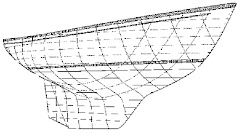We've been having intermittent problems with our diesel supply all the way down from Seattle. Since we left San Diego they've been more frequent. Basically, both engines (the main and the genset) have been behaving like they're starved for fuel. We hadn't been able to identify much of a pattern, and we were pretty much tearing our hair out trying to figure out what was going on. Earlier this week, we decided that we'd reached the end of our (admittedly short) diesel troubleshooting rope, and decided to call in a professional. This being Mexico, where marine diesel mechanics are sort of thin on the ground, it wasn't just a matter of picking up the phone. Art asked around found a guy from a big yard in Cabo who was doing work on another boat here a couple of days ago, and today he came down and took a look.
One of the things that completely confused us when we'd tried to figure out what was going on was that we couldn't figure out how the genset was getting fuel. It obviously was, since we've been running it fairly often for the ten years we've had Arione, but when we traced the lines by hand, they made no sense. They also bore no resemblance to the schematics we had from the builder, but that's not the first time that's happened - these boats were semi-custom, and the schematics are of the non-customized setup. Whatever.
Turns out the genset fuel supply is plumbed into the return from the main. How that could even work, I don't really understand, since the returns presumably go into the tops of the tanks, not the bottoms (i.e. where the fuel is) but work it did for ten years. Since we'd been babying the charging system a bit out of paranoia from the charging issues we had between Seattle and San Francisco, using the genset more and the inverter less, we started seeing problems. Turns out, that if we run the main and the genset simultaneously (which we had never, ever done before this trip), or even one right after the other, we set up all kinds of weird back pressure and suction in the fuel system. These don't necessarily manifest themselves at that exact moment - the suction from a running diesel is apparently enough to overcome a lot of resistance, but it causes problems to appear the next time we run one of the engines. Although if the next time was, say 24 hours later, sometimes it was OK, as that was long enough for the pressure to equalize itself. That's what made it so hard to see a pattern - there was one, but it was extremely subtle.
Unfortunately, today being Friday, and Monday being a holiday (Mexican Revolution Day), we're not going to make any progress on this until Tuesday at the earliest, but it's a relief to have an understanding of what's going on and a plan.
Worrying whether or not the genset was going to run on any given day was really stressing us out - I take some meds that have to be kept refrigerated, and the genset is our main way of cooling the box when we're not running the engine. It means a few more days than we'd intended in Puerto los Cabos, but I'd happily spend another week here if it meant solving this problem. As an extra bonus, we won't have to worry about what sorts of crud might be lurking in our elderly fuel lines, since we're going to have them all replaced as part of re-routing the genset supply.
The problem's not solved until it's solved, but it's a huge relief to have what looks like a reasonable hypothesis and a plan to address it. We're both going to be really glad to see Devon show up on Tuesday with his tools and a nice shiny roll of new fuel line.
RETURN TO GLORIOUS GLORIETTA BAY
8 years ago




No comments:
Post a Comment